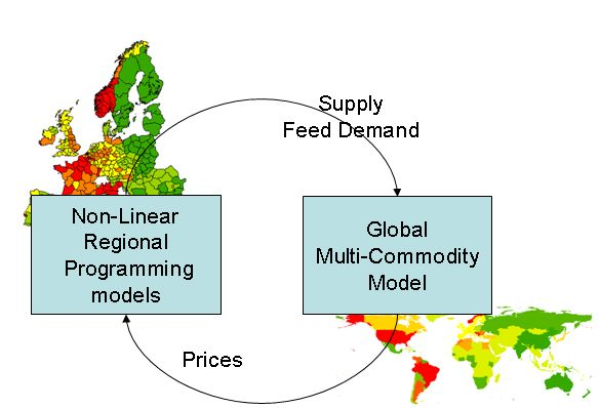CAPRI is a success story of an economic model developed by European Commission research funds. Operational since almost a decade, it supports decision making related to the Common Agricultural Policy based on sound scientific quantitative analysis. CAPRI is only viable due to its Pan-European network of researchers which based on an open source approach tender together for projects, develop and maintain the model, apply it for policy impact assessment, write scientific publications and consult clients based on its results.
General information
Global agricultural sector model with focus on EU27, Norway, Turkey and Western Balkans, iteratively linking:
Supply module (EU27+Norway+Western Balkans+Turkey): covering about 280 regions (NUTS 2 level) or even up to ten farm types for each region (in total 2,450 farm-regional models, EU27)
Market module: spatial, global multi-commodity model for agricultural products, 47 product, 77 countries in 40 trade blocks

Objective: to evaluate exante impacts of the Common Agricultural Policy and trade policies on production, income, markets, trade, and the environment, from global to regional scale
Spatial downscaling for EU27 of crop shares, yields, stocking densities, fertilizer application rates to 150.000 Homogenous Soil Mapping Units (cluster of 1×1 km grid cells) for environmental impact assessment and link to bio-physical model DNDC
Open source approach with an active network of developers and users, main client is the EU Commission.
Documentation
Documentation based on wiki 2022
Short Overview (pdf, 27 Slides)
Frequently asked question page, list of CAPRI based publications and additional technical documents
Data base
Activity based breakdown (about 50 activities) based on Economic Accounts of Agriculture, 250 regions
Farm/market balances and unit value prices at national level (about 60 products and 35 inputs)
Policy variables at regional/national (premiums, set-aside, quotas…) and EU level (tariffs, administrative prices…)
Sourced mainly by Eurostat and FAOSTAT, major effort to build a complete, closed and consistent agricultural data base across scales
Technical Solution
Economic model and data base generation realised in GAMS
Java based Graphical User Interface (GUI), allows:
Steering of different working steps (Data base updates, baseline generation, model calibration, scenario runs)
User friendly exploitation of results (tables, graphics, maps)
Read more ..



